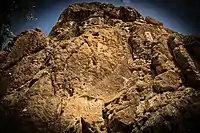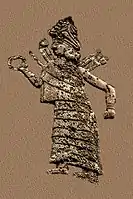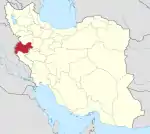
The Anubanini petroglyph, also called Sar-e Pol-e Zohab II[1] or Sarpol-i Zohab relief,[2] is a rock relief from the Akkadian Empire period (circa 2300 BC) or the Isin-Larsa period (early second millennium BC) and is located in Kermanshah Province, Iran.[2][1] The rock relief is believed to belong to the Lullubi culture and is located 120 kilometers away from the north of Kermanshah, close to Sarpol-e Zahab. Lullubi reliefs are the earliest rock reliefs of Iran, later ones being the Elamite reliefs of Eshkaft-e Salman and Kul-e Farah.
Description
In this rock relief, Anubanini, the king of the Lullubi, puts his foot on the chest of a captive. There are eight other captives, two of them kneeling behind the Lullubian equivalent of the Akkadian goddess Ishtar (recognisable by the four pairs of horns on her headdress and the weapons over her shoulders) and six of them standing in a lower row at the bottom of the rock relief.[1] He is bare-chested, only wearing a short skirt.[1]
The general style of the Anubanini relief emulates the style of Mesopotamian royal art of the period, as well as its language, in using the Akkadian language and script for this inscription.[3]
Inscription
There's also an inscription in the Akkadian language and Akkadian script. In the inscription, he declares himself as the mighty king of Lullubium, who had set up his image as well as that of Ishtar on mount Batir, and calls on various deities to preserve his monument.[4] The inscription begins with the formula:
TranscriptionAnubanini, the mighty king, king of Lullubum, erected a image of himself and an image of Goddess Ninni on the mount of Batir... (follows a lengthy curse formula invoking deities Anu, Antum, Enlil, Ninlil, Adad, Ishtar, Sin and Shamash towards anyone who would damage the monument)
The date of the rock relief is believed to be circa 2300 BC. It was damaged about 30% during the Iran-Iraq war.[6] Older photographs show in particular a nearly undamaged figure of the king.[7]

Behistun reliefs
This rock relief is very similar to the much later Achaemenid Behistun reliefs (fifth century BC), not located very far, to such an extent that it was said that the Behistun Inscription was influenced by it. The attitude of the ruler, the trampling of an enemy, the presence of a divinity, the lines of prisoners are all very similar.[2][8]
Details of the relief
 The Sarpul mountain, on which the relief is located (in the shadow of the edge closest to the camera). The city of Sarpul lays at the foot of the mountain.
The Sarpul mountain, on which the relief is located (in the shadow of the edge closest to the camera). The city of Sarpul lays at the foot of the mountain. The relief is located at a height of 16 meters, on the top of a cliff towering over the village of Sarpol-e Zahab. A second relief (relief of Gotarzes II, Parthian Empire) appears below.
The relief is located at a height of 16 meters, on the top of a cliff towering over the village of Sarpol-e Zahab. A second relief (relief of Gotarzes II, Parthian Empire) appears below.
 Lullubi-ki ("Country of the Lullubi") on the Anubanini Rock Relief
Lullubi-ki ("Country of the Lullubi") on the Anubanini Rock Relief

 Prisoners and their king (detail).[1]
Prisoners and their king (detail).[1]
 Anubanini rock relief Akkadian language and Akkadian script inscription.[1]
Anubanini rock relief Akkadian language and Akkadian script inscription.[1] Portrait of King Anubanini.
Portrait of King Anubanini.
Early depictions
The French architect Pascal Coste painted the rock relief as early as 1840.
 Drawing by Pascal Coste
Drawing by Pascal Coste Anubanini rock relief woodprint
Anubanini rock relief woodprint Modern drawing of the relief
Modern drawing of the relief
Other reliefs in the area
The same area of Sar-e Pol-e Zahab, has three more, less well-preserved reliefs.
Lullubian reliefs
Another relief named Sar-e Pol-e Zohab I is about 200 meters away, in a style similar to the Anubanini relief, but this time with a beardless ruler.[1] The attribution to a specific ruler remains uncertain.[1] There are also other Lullubian relief in the same area of Sar-e Pol-e Zahab, showing a beardless warrior trampling a foe, facing a goddess.[1][13]

.jpg.webp) Outline of relief I (extracted). Beardless warrior with axe, trampling a foe. Sundisk above. A name "Zaba(zuna), son of ..." can be read.[14]
Outline of relief I (extracted). Beardless warrior with axe, trampling a foe. Sundisk above. A name "Zaba(zuna), son of ..." can be read.[14] Sar-e Pol-e Zahab, relief III. Beardless warrior trampling a foe, facing a goddess.[1]
Sar-e Pol-e Zahab, relief III. Beardless warrior trampling a foe, facing a goddess.[1] Sar-e Pol-e Zahab, relief IV. Beardless warrior trampling a foe, facing a goddess.[1]
Sar-e Pol-e Zahab, relief IV. Beardless warrior trampling a foe, facing a goddess.[1]
Parthian relief
Another relief is located below the Anubanini relief, lower on the cliff. This relief was created during the Parthian Empire in the name of Gotarzes, possibly Gotarzes I, but more probably the Parthian king Gotarzes II, who ruled from 39 to 51 CE and is known to have made other reliefs, such as the equestrian relief at Behistun.[17][18]
 The second relief, below the Anubanini relief, a Parthian relief.
The second relief, below the Anubanini relief, a Parthian relief. Drawing of the Parthian relief.
Drawing of the Parthian relief.
Dukkan-e Daud Late Achemenid tomb
At Dukkan-e Daud, not far from Sar-e Pol-e Zohab, there is a late Achaemenid tomb (circa 400–300 BCE) with the relief of a Zoroastrian priest.
See also
References
- 1 2 3 4 5 6 7 8 9 10 11 12 13 14 15 16 Osborne, James F. (2014). Approaching Monumentality in Archaeology. SUNY Press. pp. 123–124. ISBN 9781438453255.
- 1 2 3 Potts, D. T. (1999). The Archaeology of Elam: Formation and Transformation of an Ancient Iranian State. Cambridge University Press. p. 318. ISBN 9780521564960.
- ↑ Sasson, Jack M. (1995). Civilizations of the Ancient Near East. Scribner. p. 254. ISBN 9780684197203.
- 1 2 Cameron, George G. (1936). History of Early Iran (PDF). The University of Chicago Press. p. 35.
- ↑ Morgan (1900). Mémoires. Mission archéologique en Iran. p. 67.
- ↑ "نقش برجسته آنوبانی نی؛ تصویری از تمدن هزاران ساله کرمانشاه". Isna News Agency. Retrieved 24 December 2015.
- ↑ Older photograph of the relief
- ↑ Wiesehofer, Josef (2001). Ancient Persia. I. B. Tauris. p. 13. ISBN 9781860646751.
- ↑ Osborne, James F. (2014). Approaching Monumentality in Archaeology. SUNY Press. p. 123. ISBN 9781438453255.
- ↑ Hamblin, William J. (2006). Warfare in the Ancient Near East to 1600 BC. Routledge. ISBN 9781134520626.
- ↑ Barjamovic, Gojko (2016). Problems of Canonicity and Identity Formation in Ancient Egypt and Mesopotamia. Museum Tusculanum Press. pp. 220, Note 11. ISBN 9788763543729.
- ↑ " He wears a feather crown such as that found in a few hammered bronzes of Luristan belonging to the early first millennium B.C." in Ancient Iran. 1965. p. 43.
- ↑ Vanden Berghe, Louis. Relief Sculptures de Iran Ancien. pp. 19-21.
- 1 2 Osborne, James F. (2014). Approaching Monumentality in Archaeology. SUNY Press. pp. 123–124. ISBN 9781438453255.
- ↑ Osborne, James F. (2014). Approaching Monumentality in Archaeology. SUNY Press. pp. 123–124. ISBN 9781438453255.
- ↑ Frayne, Douglas (1990). Old Babylonian Period (2003-1595 BCE). University of Toronto Press. pp. 707 ff. ISBN 9780802058737.
- ↑ Vanden Berghe, Louis. Relief Sculptures de Iran Ancien. p. 45.
- ↑ Deuren, Greet van (2017). Iran (in Dutch). Gottmer Uitgevers Groep b.v. ISBN 9789025763961.





